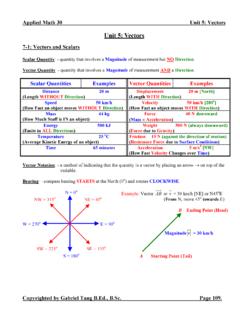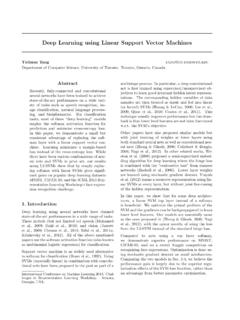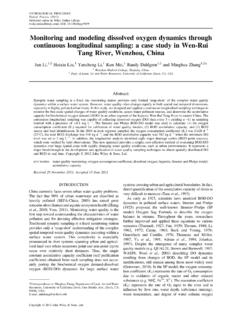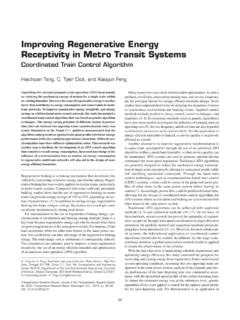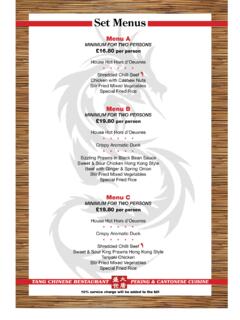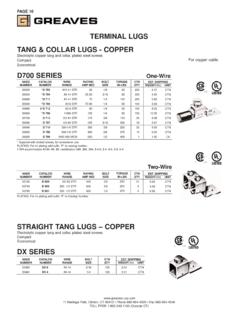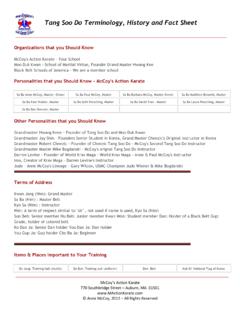Transcription of Lab 08 Chemical Equilibrium - doctortang.com
1 Honour Chemistry Lab #8 Page 1 of 4. Lab #8: Chemical Equilibrium Objective: To observe and explain the effect of an applied stress on Chemical systems at Equilibrium by applying the Le Ch telier s Principle. Background Information: In this lab, the effect of applying stresses to a variety of Chemical systems at Equilibrium will be explored. The Equilibrium systems to be studied are given below: 1. Saturated Sodium Chloride Solution: NaCl (s) Na+(aq) + Cl (aq) 2. Acidified Chromate Solution: 2 CrO42 (aq) + 2 H+(aq) Cr2O72 (aq) + H2O (l) (yellow) (acid) (red) 3. Ammonia Solution (with phenolphthalein): NH3 (aq) + H2O (l) NH4+ + OH (aq) + Heat (NH3 clear in phenolphthalein) (OH is pink in phenolphthalein) 4.
2 Cobalt (II) Chloride Solution: Co(H2O)62+(aq) + 4 Cl (aq) + Heat CoCl42 (aq) + 6 H2O (l) (reddish-pink) (blue) 5. Iron (III) Thiocyanate Solution: Fe3+(aq) + SCN (aq) Fe(SCN) (aq) + Heat (pale yellow) (colourless) (deep red) By observing the changes that occur (colour changes, precipitate formation, etc.) the direction of a particular shift may be determined. Such shifts may then be explained by carefully examining the effect of the applied stress as dictated by Le Ch telier s Principle. Hypotheses: Predict the shift in Equilibrium and possible observations for the following situations. 1. Saturated Sodium Chloride Solution: NaCl (s) Na+(aq) + Cl (aq) a.
3 Adding HCl (aq) 2. Acidified Chromate Solution: 2 CrO42 (aq) + 2 H+(aq) Cr2O72 (aq) + H2O (l) (yellow) (acid) (red) a. Adding HNO3 (aq) first b. Adding NaOH (aq) after in the same test tube (H+ + OH forms H2O) 3. Ammonia Solution (with phenolphthalein): NH3 (aq) + H2O (l) NH4+ + OH (aq) + Heat (NH3 clear in phenolphthalein) (OH is pink in phenolphthalein) a. Adding NH4Cl (s) b. Decreasing Temperature c. Increasing Temperature 4. Cobalt (II) Chloride Solution: Co(H2O)62+(aq) + 4 Cl (aq) + Heat CoCl42 (aq) + 6 H2O (l) (reddish-pink) (blue) a. Adding H2O (l) b. Adding HCl (aq) c. Adding AgNO3 (aq) d.
4 Decreasing Temperature e. Increasing Temperature 5. Iron (III) Thiocyanate Solution: Fe3+(aq) + SCN (aq) Fe(SCN) (aq) + Heat (pale yellow) (colourless) (deep red) a. Adding Fe(NO3)3 (aq) b. Adding KSCN (aq) c. Adding K2 HPO4 (aq) (HPO42 (aq) and Fe3+(aq) forms a complex FeHPO4+ (aq)) d. Decreasing Temperature Honour Chemistry Lab #8 Page 2 of 4. Materials: 14 Small Test Tubes Stirring Rods 6 M HNO3 (aq) M AgNO3 (aq) Test Tube Racks Medicine Droppers 6 M NaOH (aq) M Fe(NO3)3 (aq) Bunsen Burner Ice and Water Diluted NH3 (aq)* M KSCN (aq) 2 Beakers (250 mL) Saturated NaCl (aq) NH4Cl (s) M K2 HPO4 (aq) Test Tube Clamps Phenolphthalein M K2 CrO4 (aq) M K2Cr2O7 (aq) Scoopula 12 M HCl (aq) M CoCl2 (aq) M KCl (aq) To make the acidify chromate solutions, combine equal volumes of M of K2 CrO4 (aq) and M K2Cr2O7 (aq).
5 Add about one-tenth of the original volume of 6 M HNO3 (aq). The initial colour of the final solution should be orange. * Prepare a stock solution by adding 4 drops of concentrated 6 M NH3 (aq) and 3 drops of phenolphthalein to a medium beaker, then topping it up with 250 mL of water. Mix with a stirring rod. The entire class can share this stock solution. CoCl2 (s) forms complex ions, Co(H2O)62+(aq) and CoCl42 (aq), when dissolves in water. An Equilibrium cobalt (II) chloride solution with its complex ions can be prepared by mixing twice equal volume of M CoCl2 (aq) with M KCl (aq). Prepare a stock solution of iron (III) thiocyanate by adding 10 mL of M FeCl3 (aq) and 10 mL of M KSCN (aq) to a medium beaker, then topping it up with 100 mL of water.
6 Mix with a stirring rod. The entire class can share this stock solution. Procedure: Record all observations on your report form. These should include, but not be limited to, colour changes and precipitates. Note that solution volumes are approximate for all reactions below. Dispose of all Chemical waste in the plastic container in the fume hood. Safety All of the acids and bases used in this experiment (HCl (aq), HNO3 (aq) and NaOH (aq)) can cause Chemical burns. In particular, concentrated 12 M HCl and 6 M HNO3 are extremely dangerous! If any of these chemicals spill on you, immediately rinse the affected area under running water and notify your instructor. Also note that direct contact with silver nitrate (AgNO3) will cause dark discolourations to appear on your skin.
7 These spots will eventually fade after repeated rinses in water. Finally, in Parts 3, 4 and 5, you will be heating a solution in a test tube directly in a Bunsen Burner flame. If the solution is overheated it will splatter out of the tube, so be careful not to point the tube towards anyone while heating. Part 1: Saturated Sodium Chloride Solution (Demo: 1 test tube) 1. Place 2 mL (about the width of a thumb nail) of saturated NaCl (aq) into a small test tube. Record the initial observation. 2. (Demo) Observe as your instructor carefully add the concentrated 12 M HCl (aq) drop-wise to the test tube containing the saturated NaCl (aq) until a distinct change occurs. Record your observations. Part 2: Acidified Chromate Solution (1 test tube) 1.
8 Place about 2 mL (about the width of a thumb nail) of M K2 CrO4 (aq) / K2Cr2O7 (aq) into a small test tube. Label this as test tube #1. Record the initial observation. 2. Carefully add concentrated 6 M HNO3 (aq) drop-wise to this solution. Record your observations. 3. To the same test tune, carefully add concentrated 6 M NaOH (aq) drop-wise until a distinct change occurs. Record your observations. Honour Chemistry Lab #8 Page 3 of 4. Part 3: Aqueous Ammonia Solution (2 test tubes) 1. To each of the two test tubes, place 2 mL (about the width of a thumb nail) of the previously diluted NH3 (aq) solution with phenolphthalein. Label these test tubes #2 & #3. Record the initial observation. 2. Add a medium scoop of NH4Cl (s) powder to test tube #2 until it is completely dissolve.
9 Record your observations. 3. Take test tube #3 and add a few drops of phenolphthalein and place it in the beaker full of ice. Wait until a distinct change occurs. Be patient. Record your observations. 4. Take the previous test tube #3 from the beaker of ice. Heat the test tube over the Bunsen Burner flame by firmly holding it with the test tube clamp, and waft it back and forth through the flame (to prevent overheating and bumping ) for about 30 seconds, or, until a distinct change occurs. Record your observations. Place the test tube in a beaker of room temperature water when finished. Remove the test tube clamp from the test tube only when it is cooled. Part 4: Cobalt (II) Chloride Solution (4 test tubes) 1. To each of the four test tubes, place 2 mL (about the width of a thumb nail) of M CoCl2 (aq).
10 Label these test tubes 4 to 7. Record the initial observation. 2. The solution in test tube #4 remains untouched. It is a control for comparison with other tubes. 3. Add about 4 mL of water to one of the test tube #5. Record your observations. 4. (Demo) Observe as your instructor carefully add the concentrated 12 M HCl (aq) drop-wise to a test tube containing the M CoCl2 (aq). Record your observations. 5. Add M AgNO3 (aq) drop-wise to the fourth test tube #6 until any distinct changes occur. Record your observations. 6. Take the last test tube, #7 and place it in the beaker full of ice. Wait until a distinct change occurs. Be patient. Record your observations. 7. Take the previous test tube #7 from the beaker of ice.
